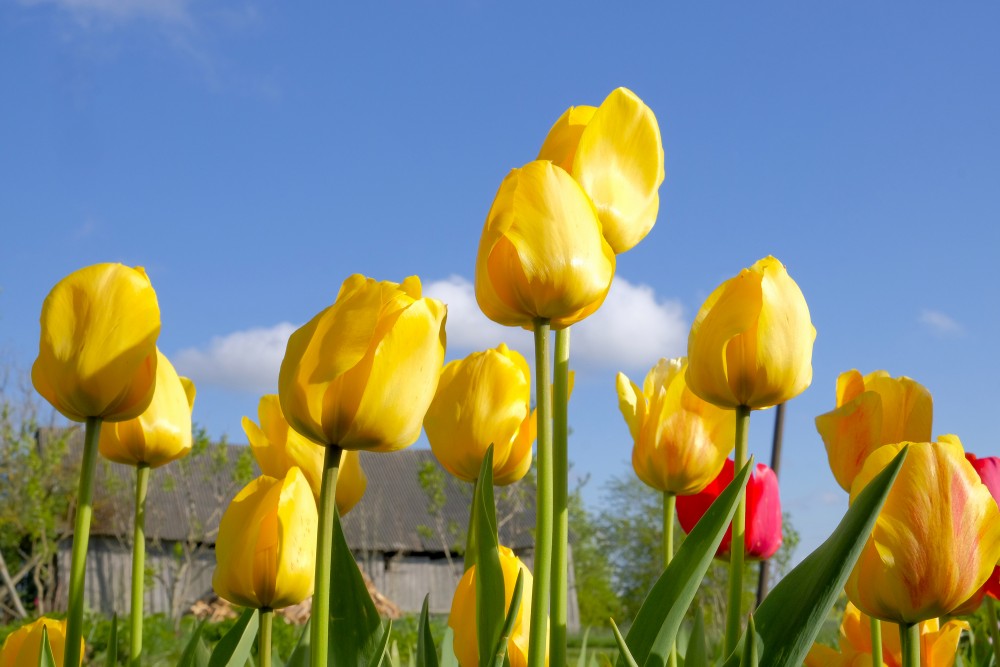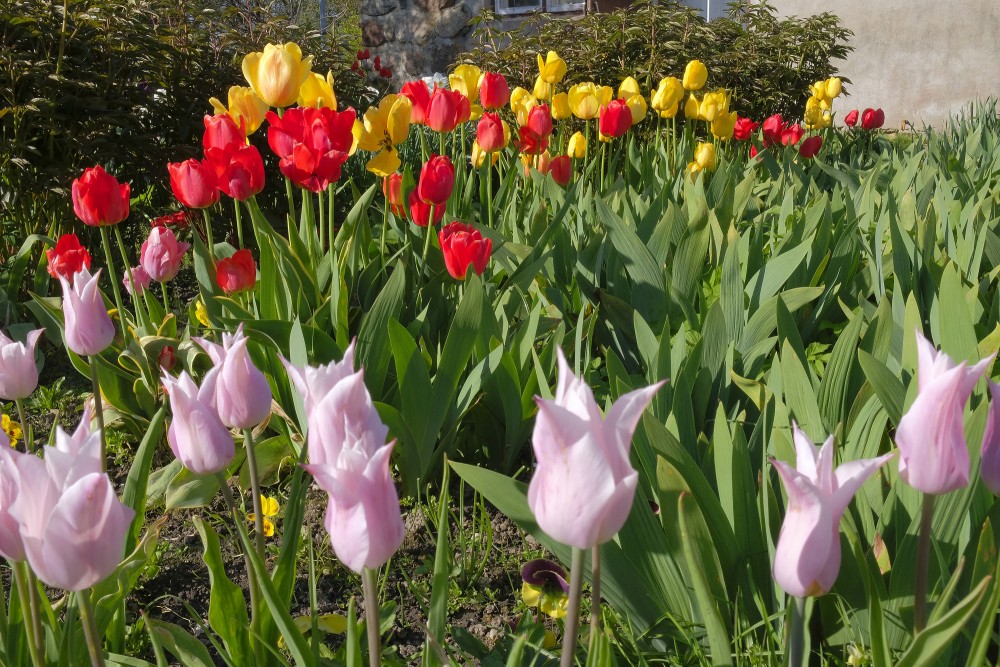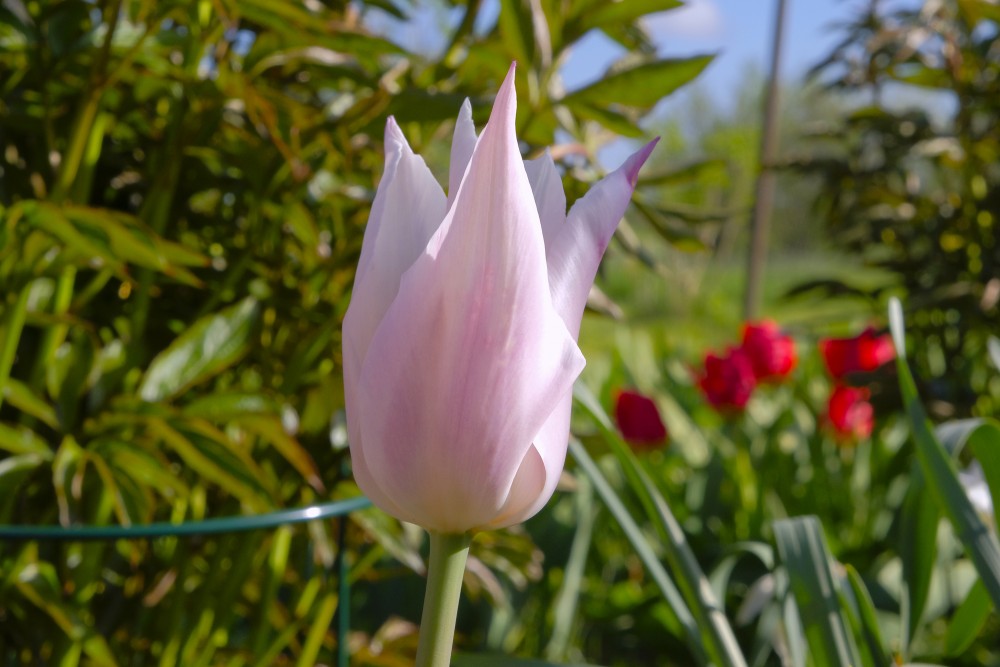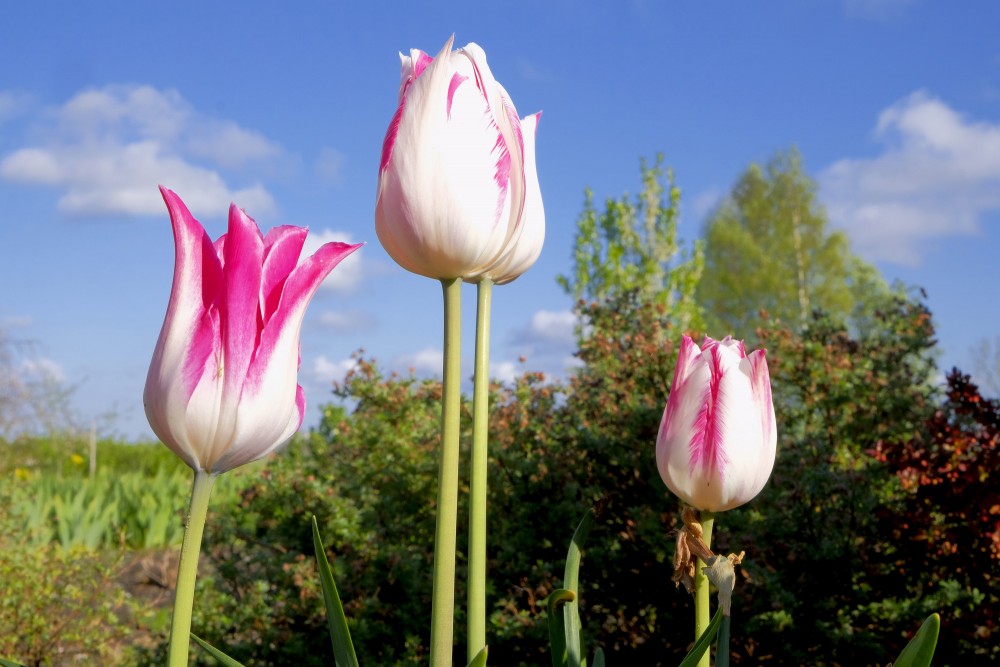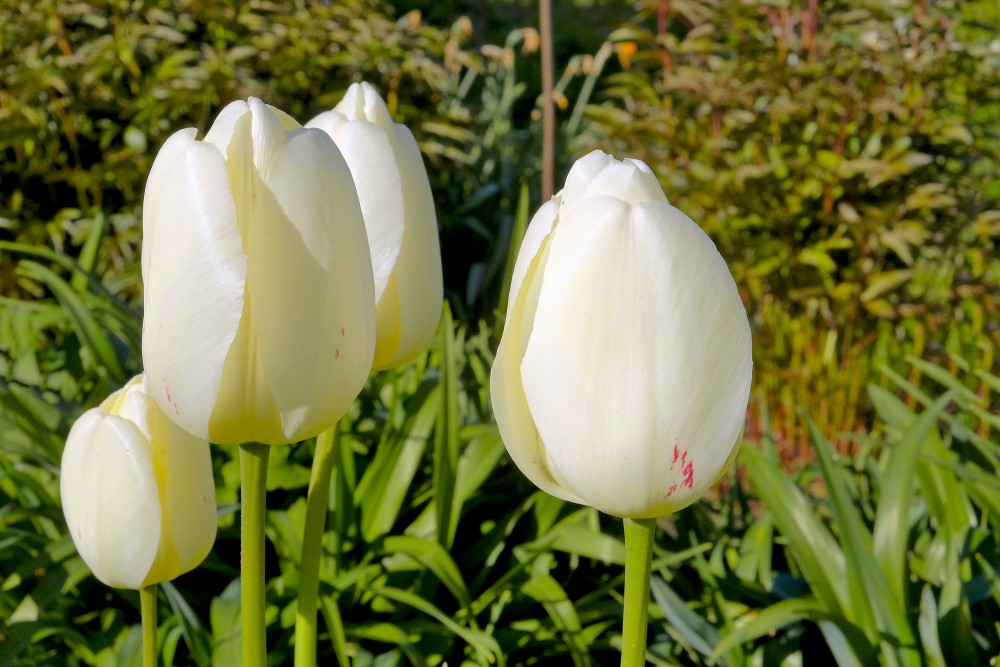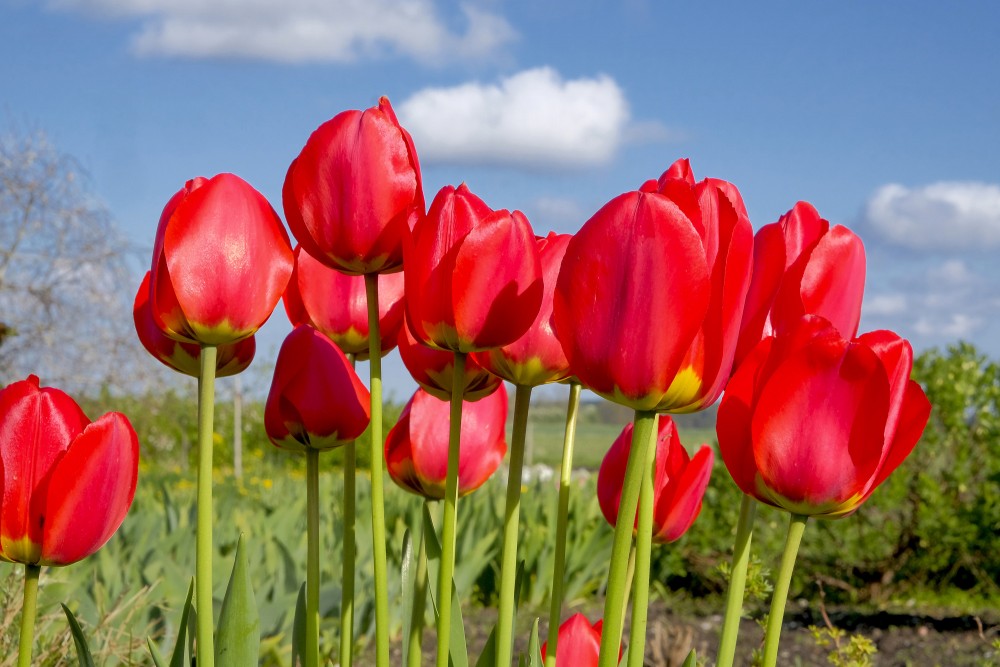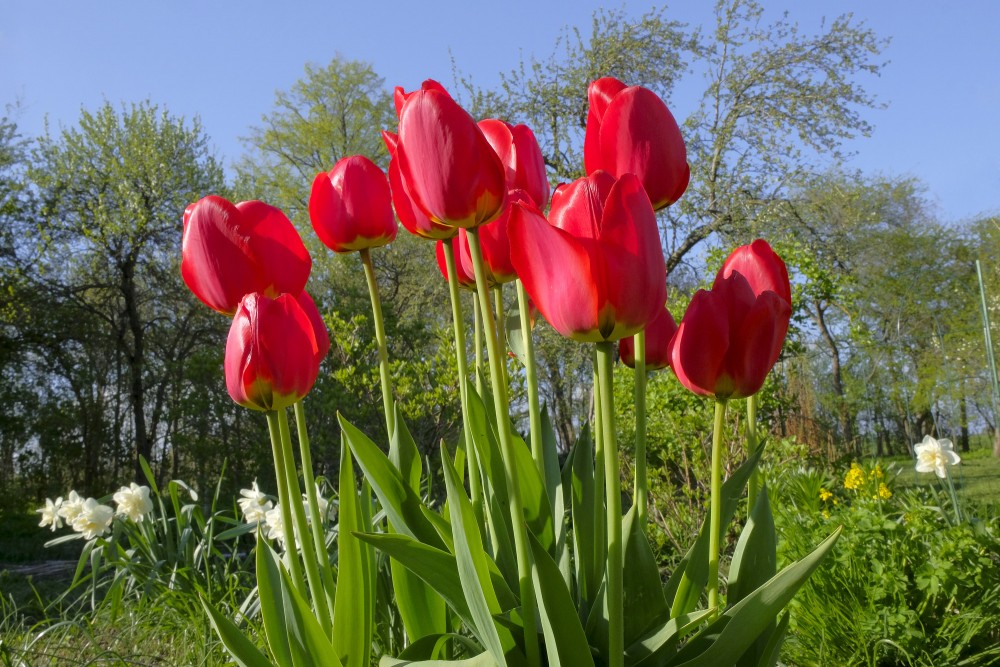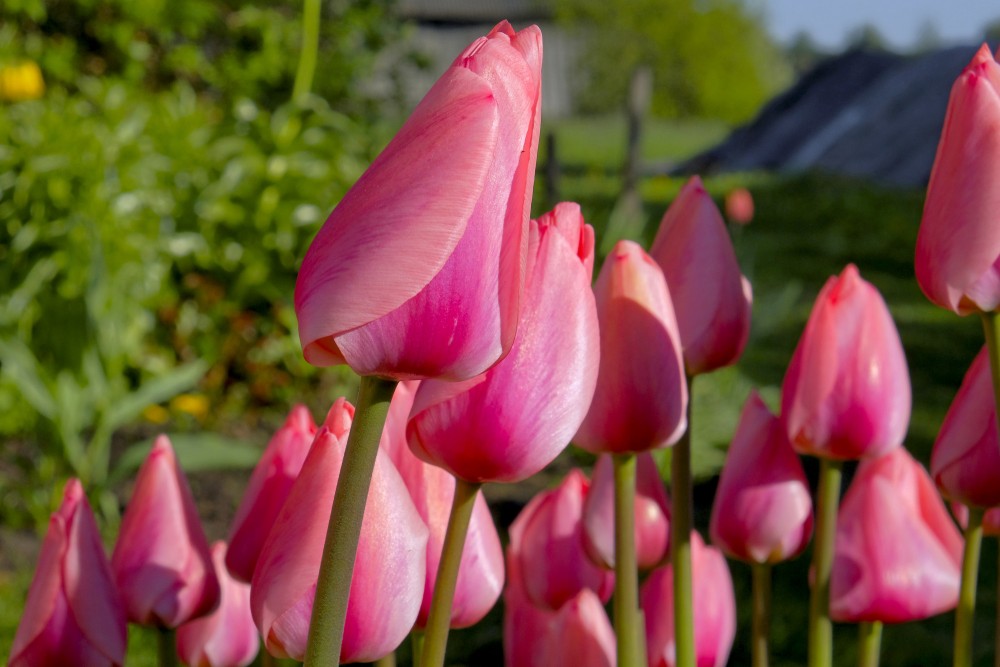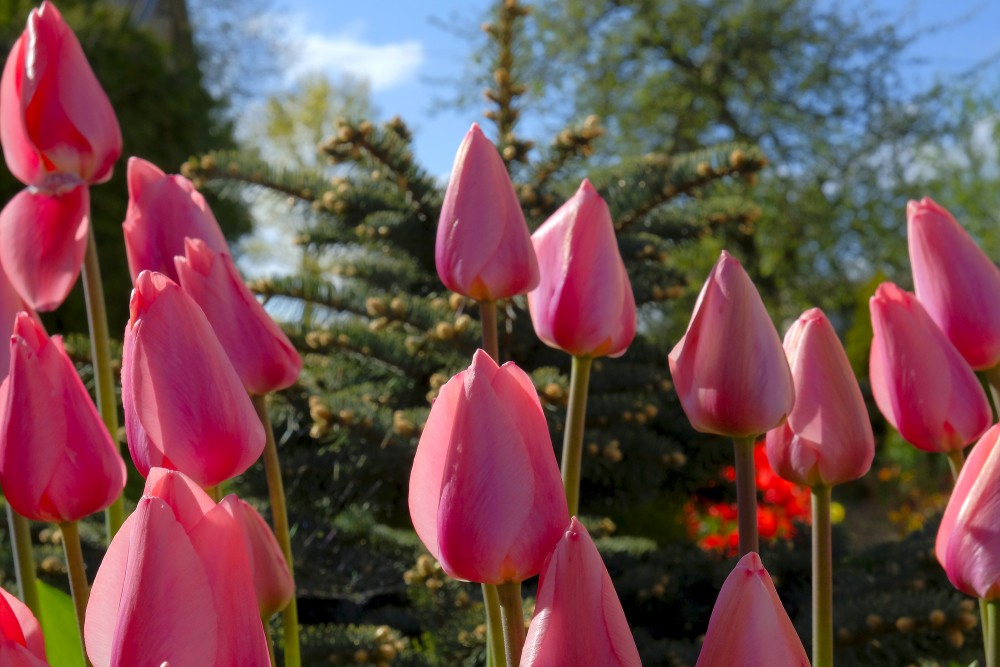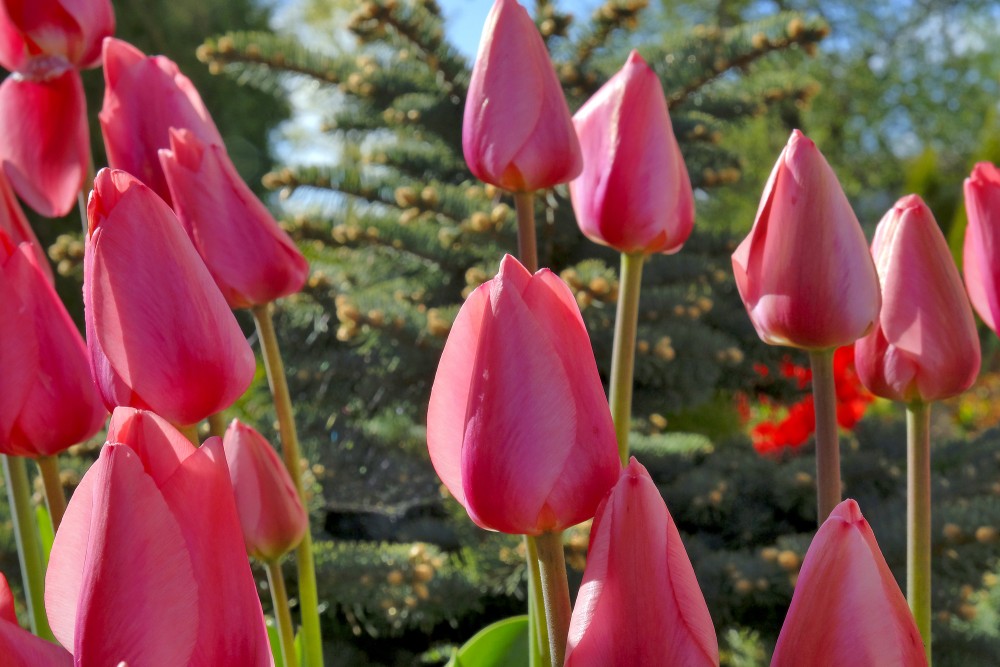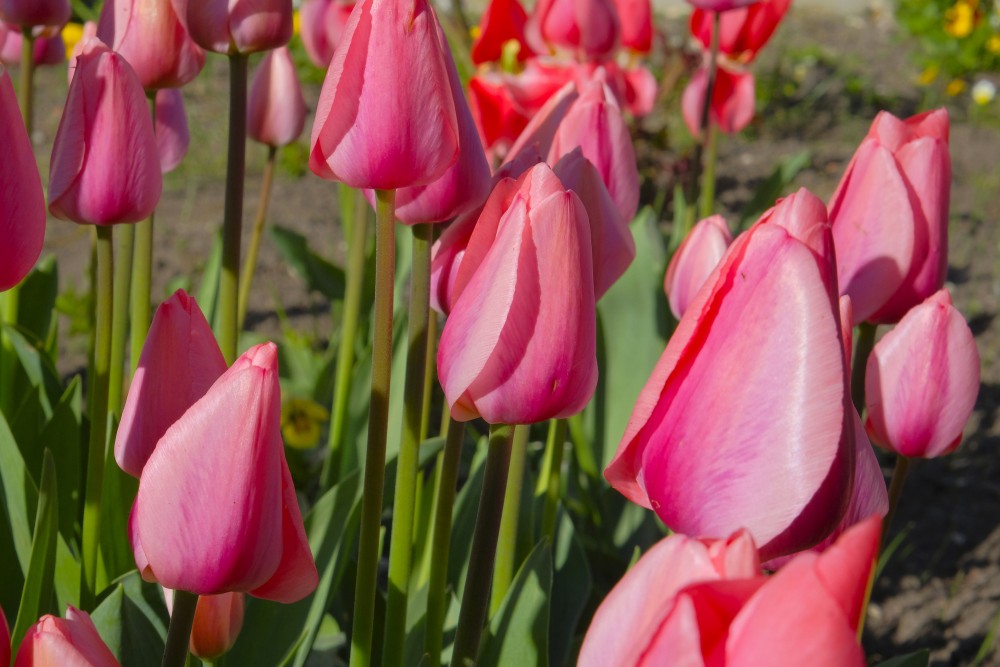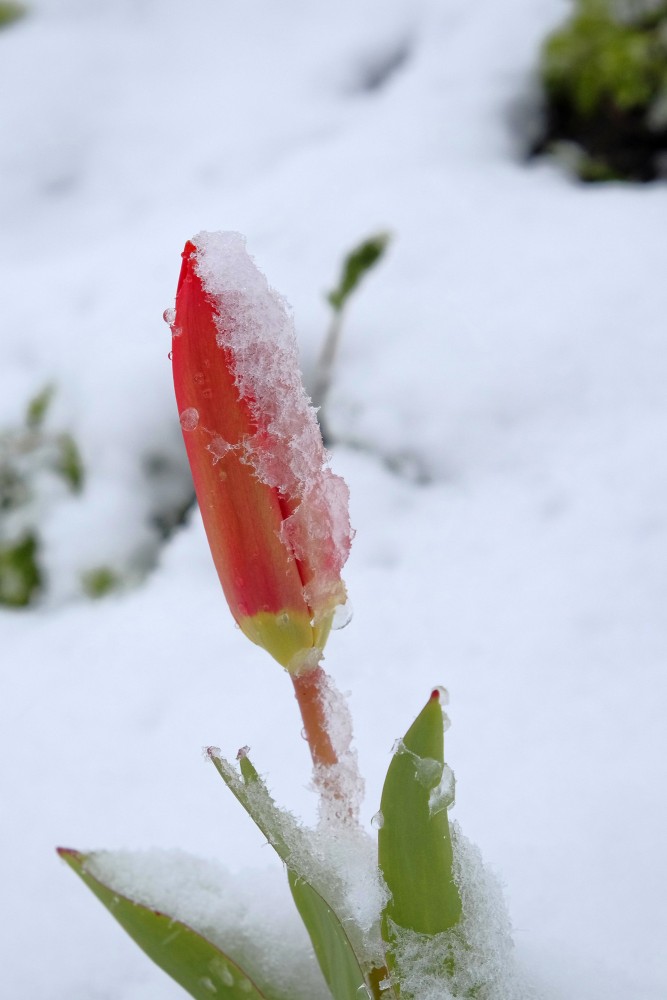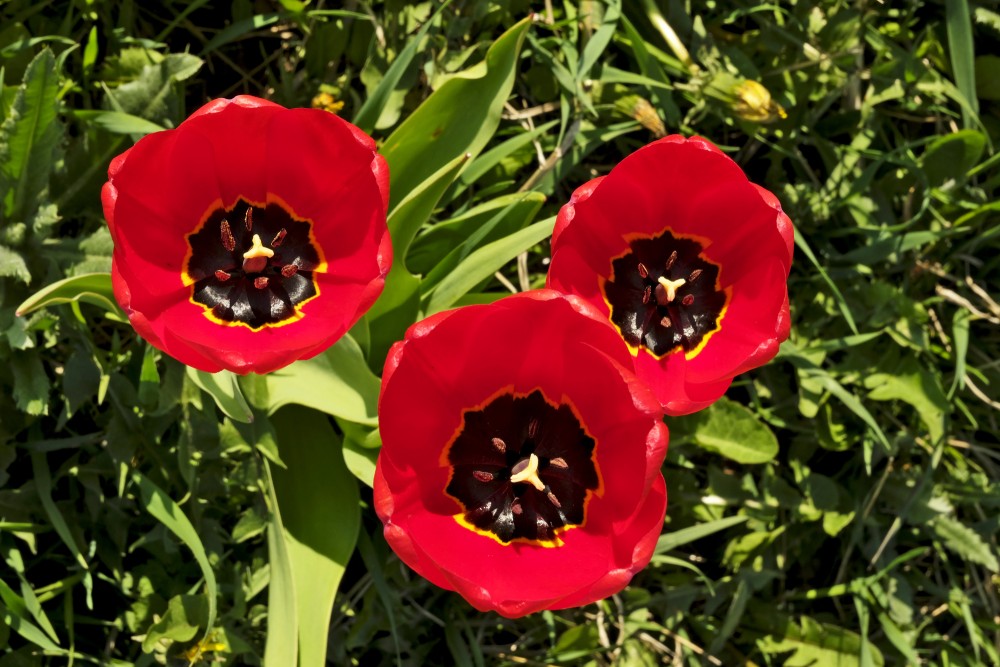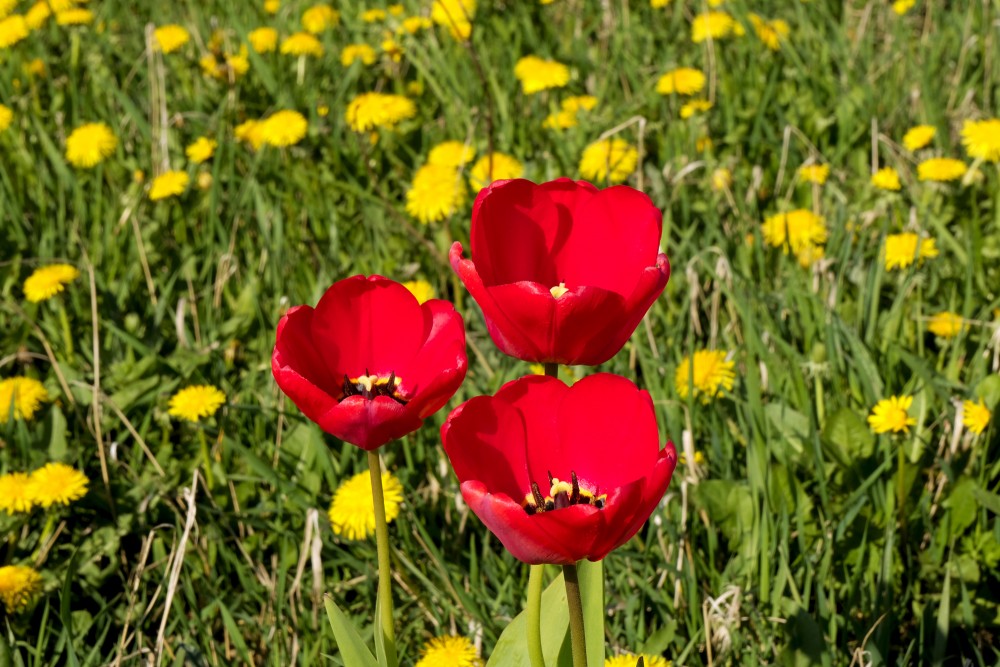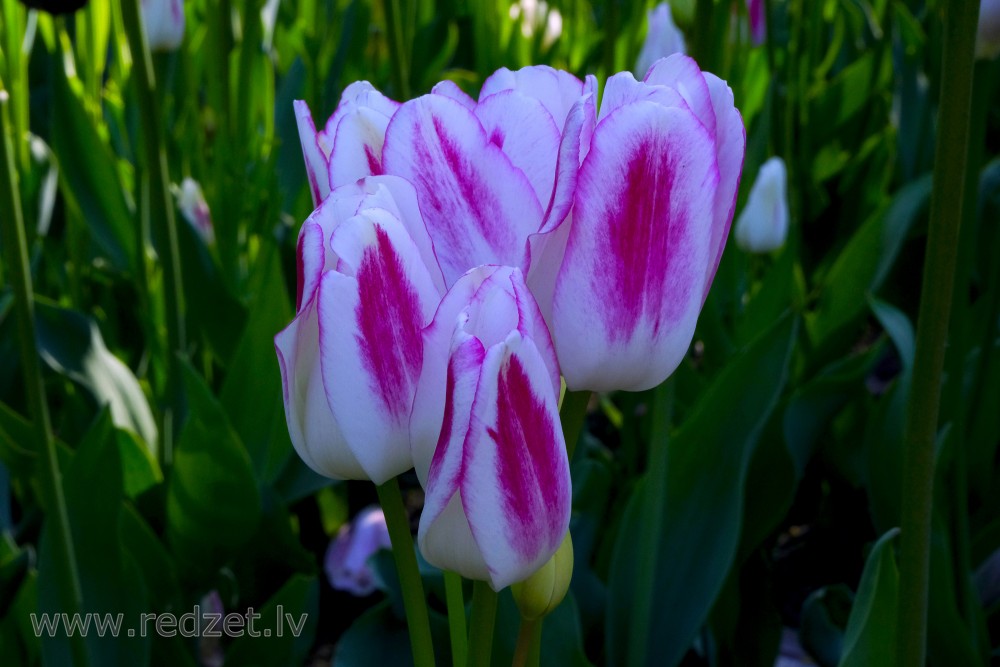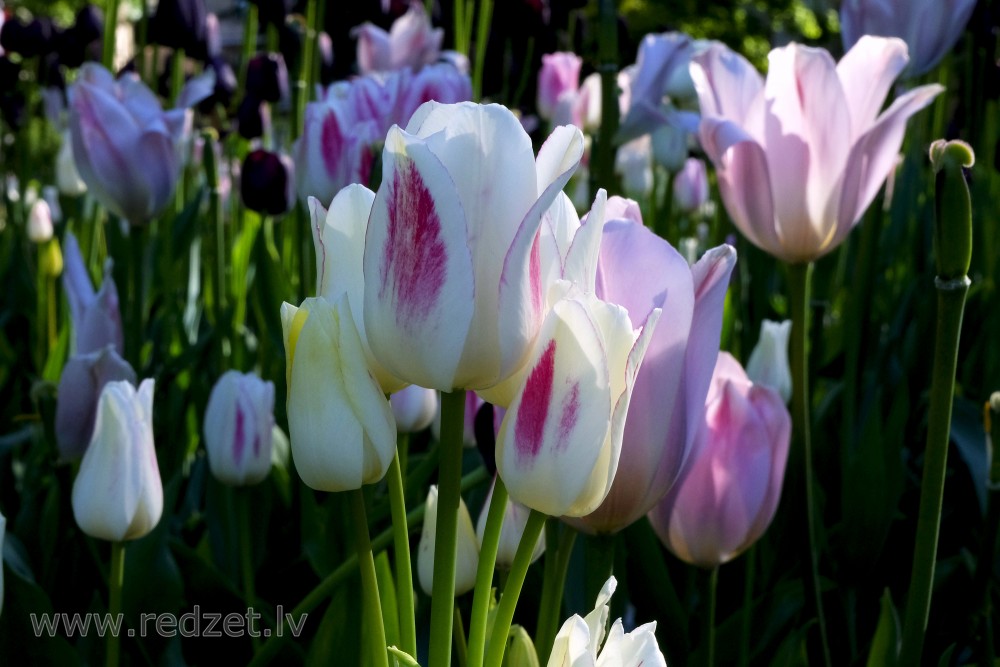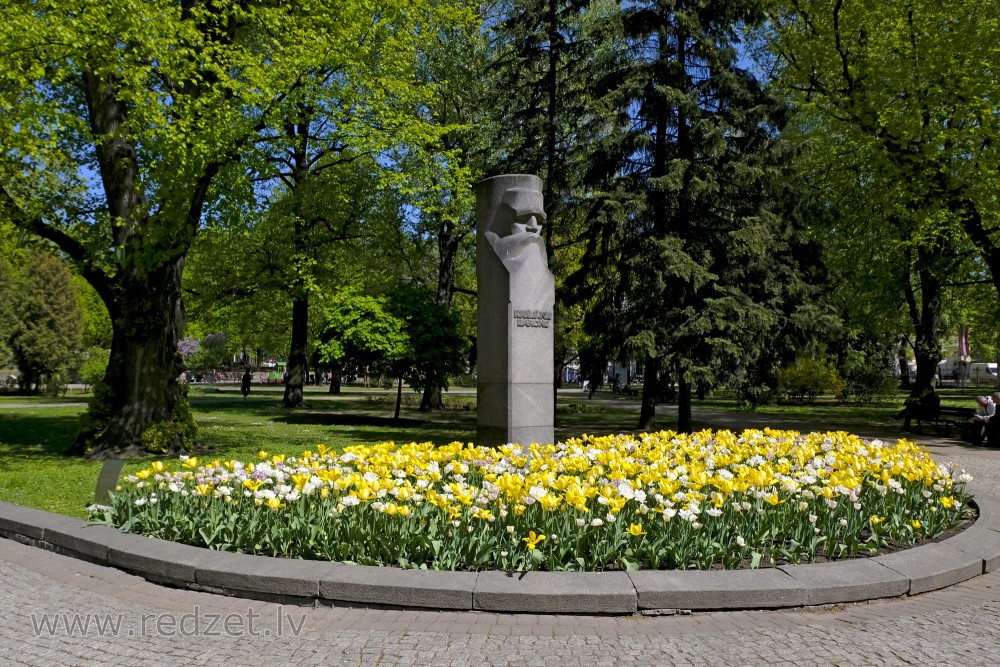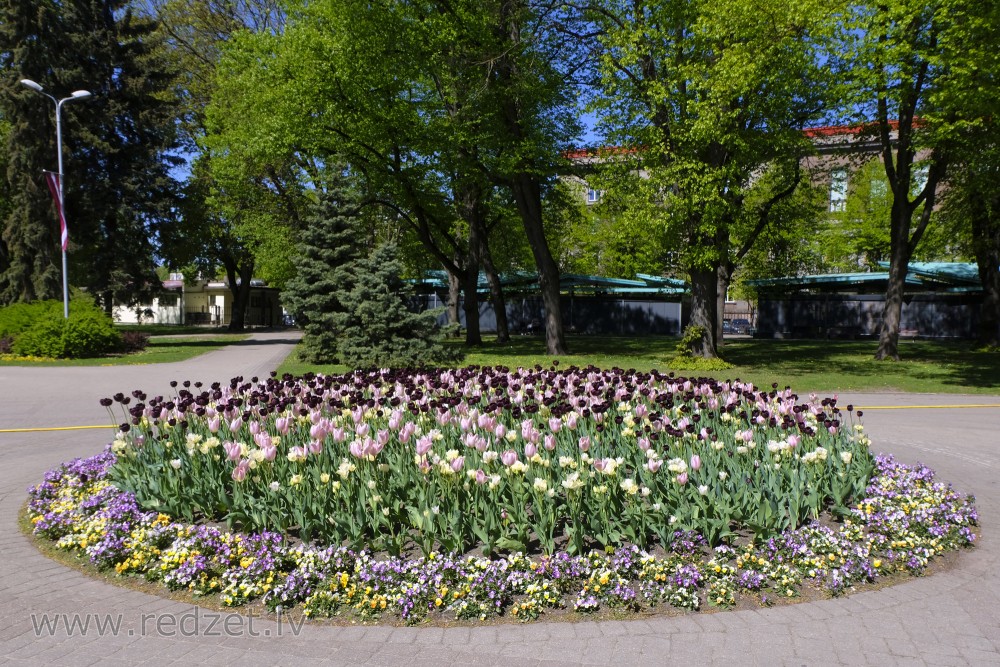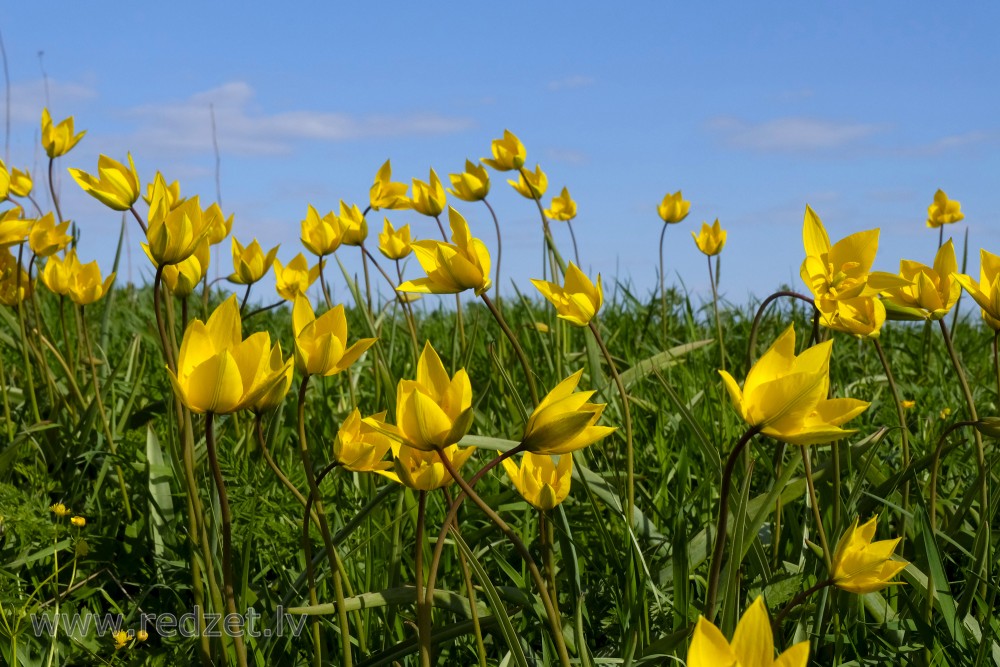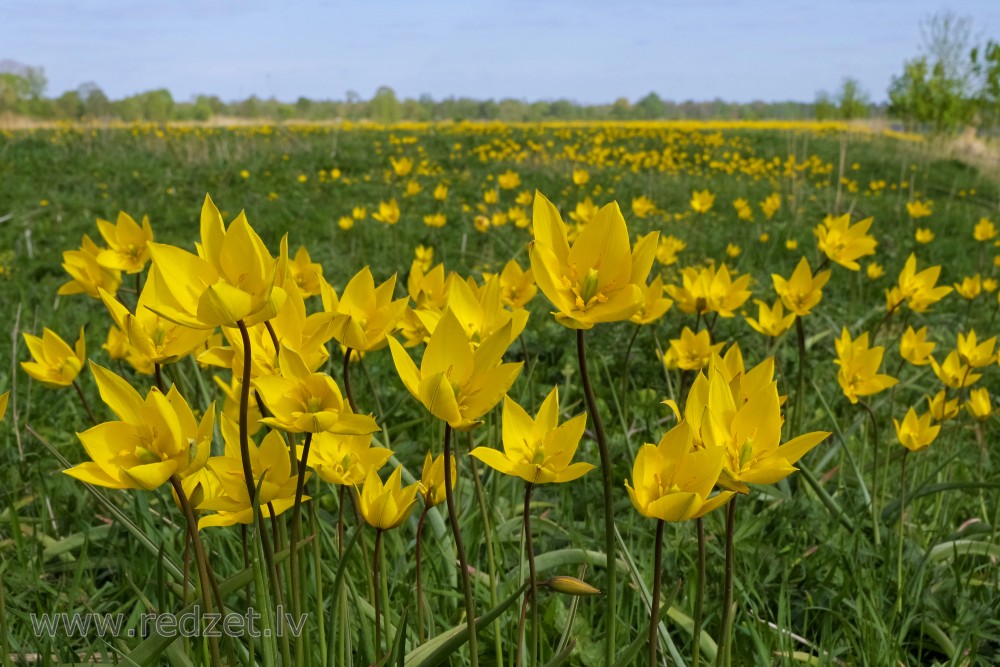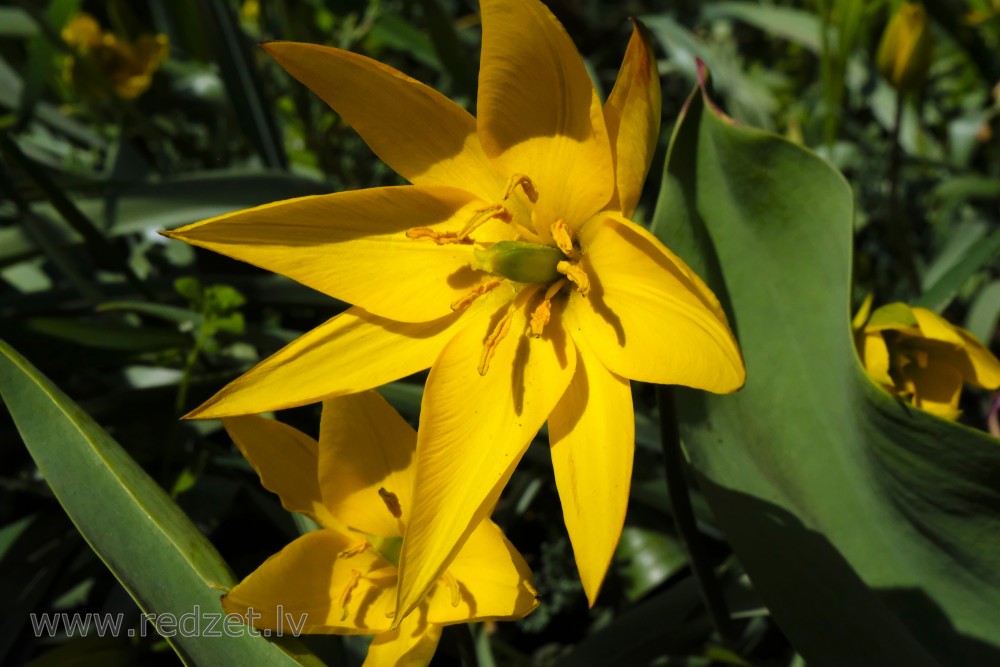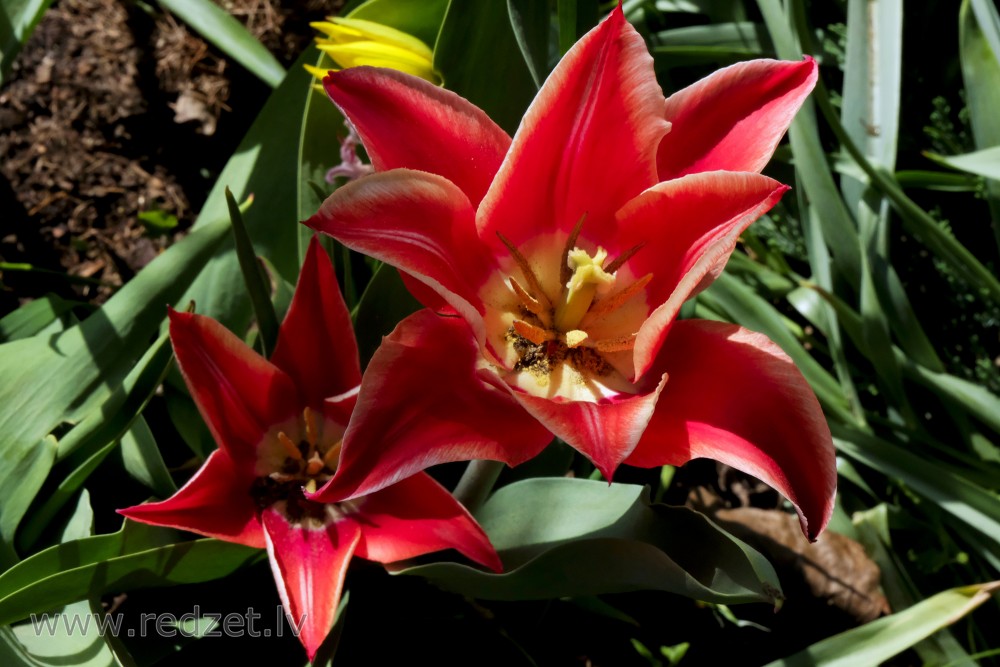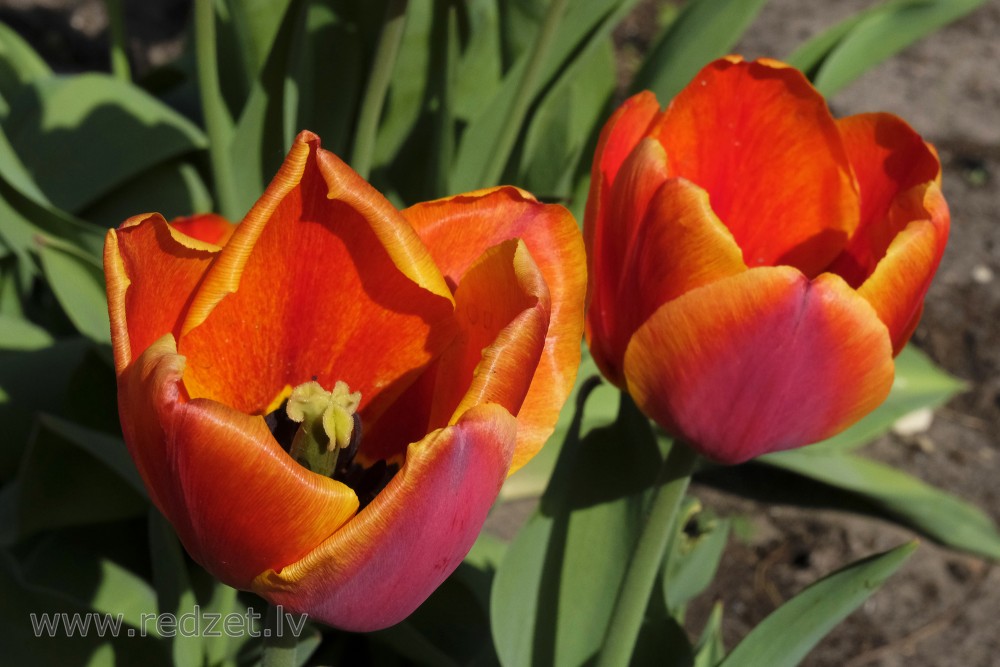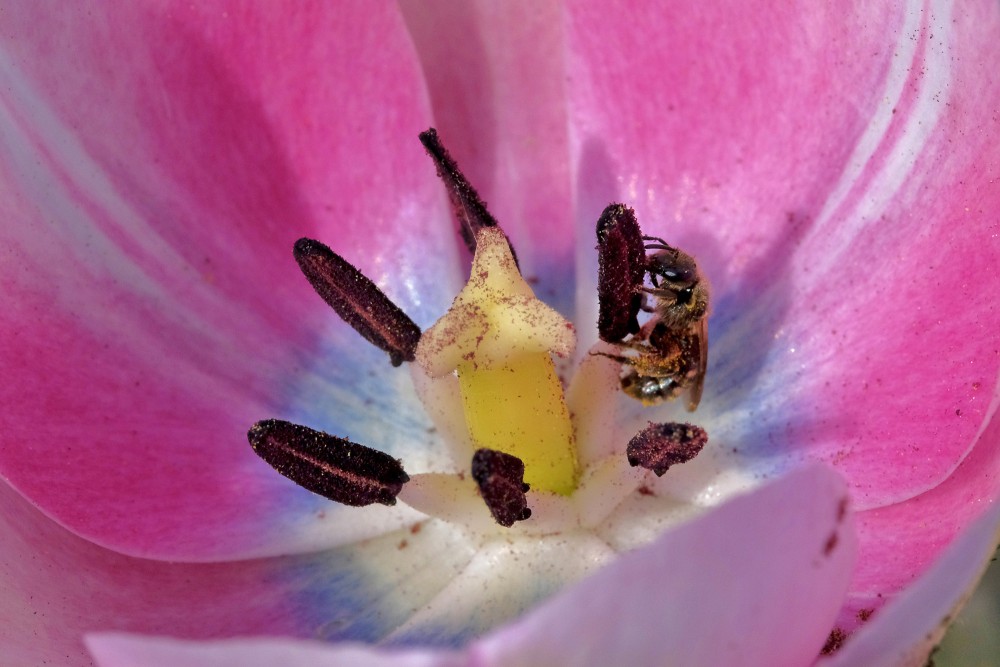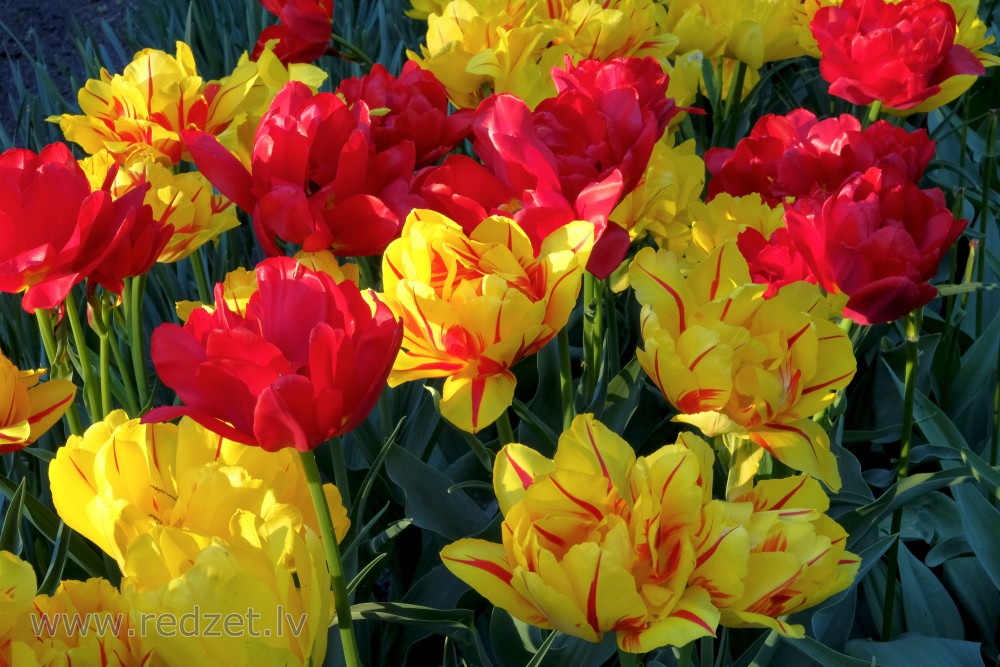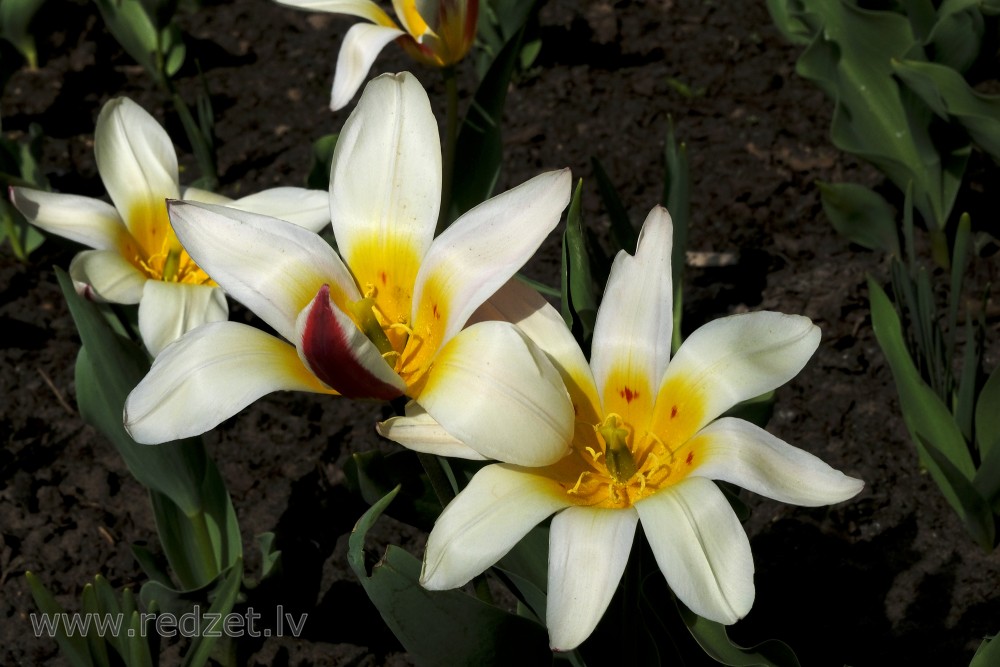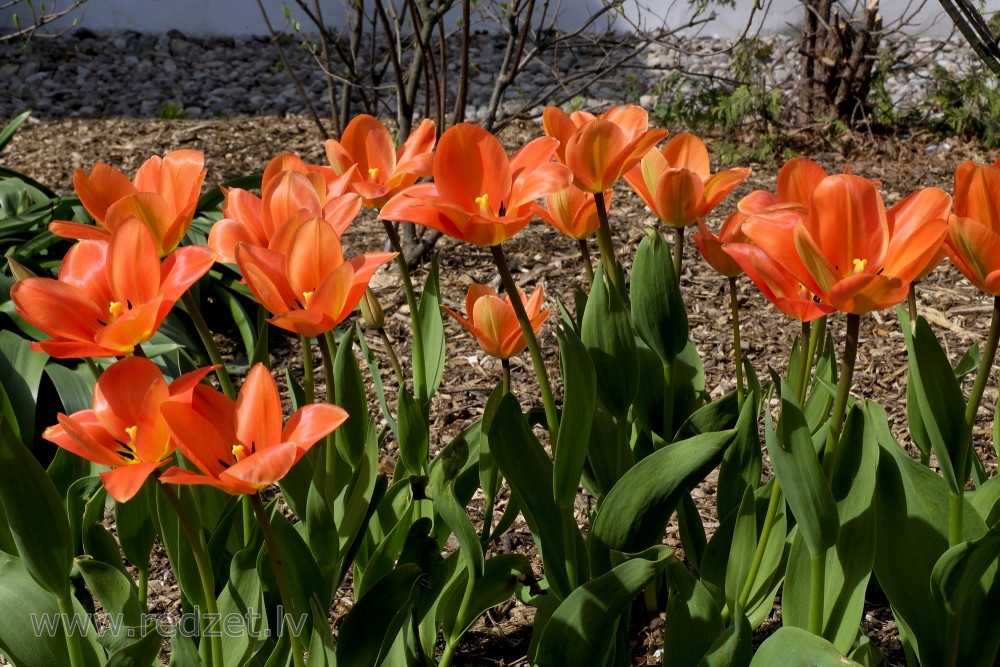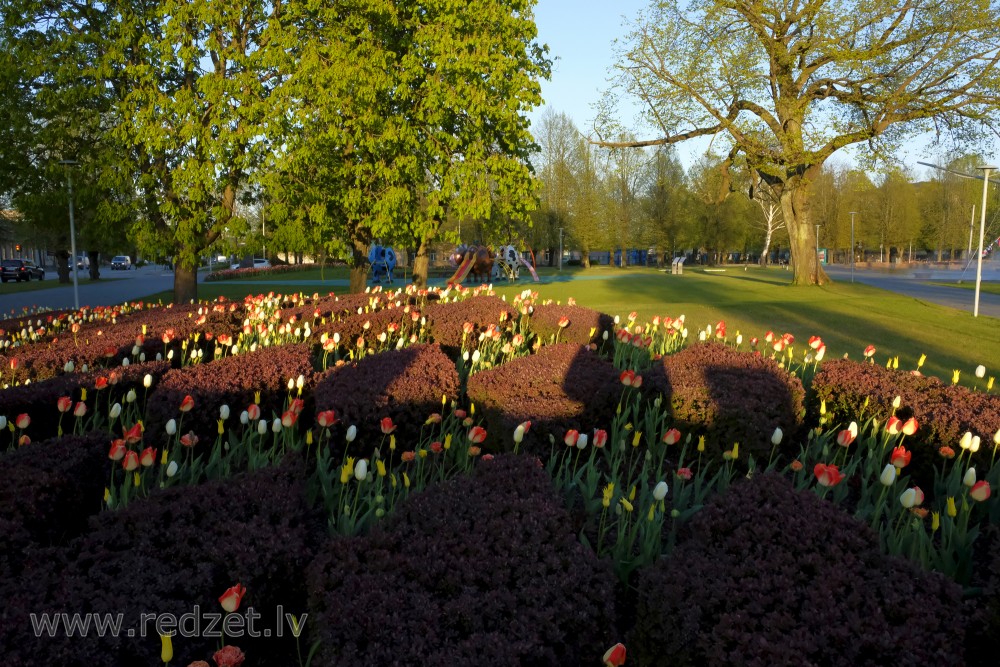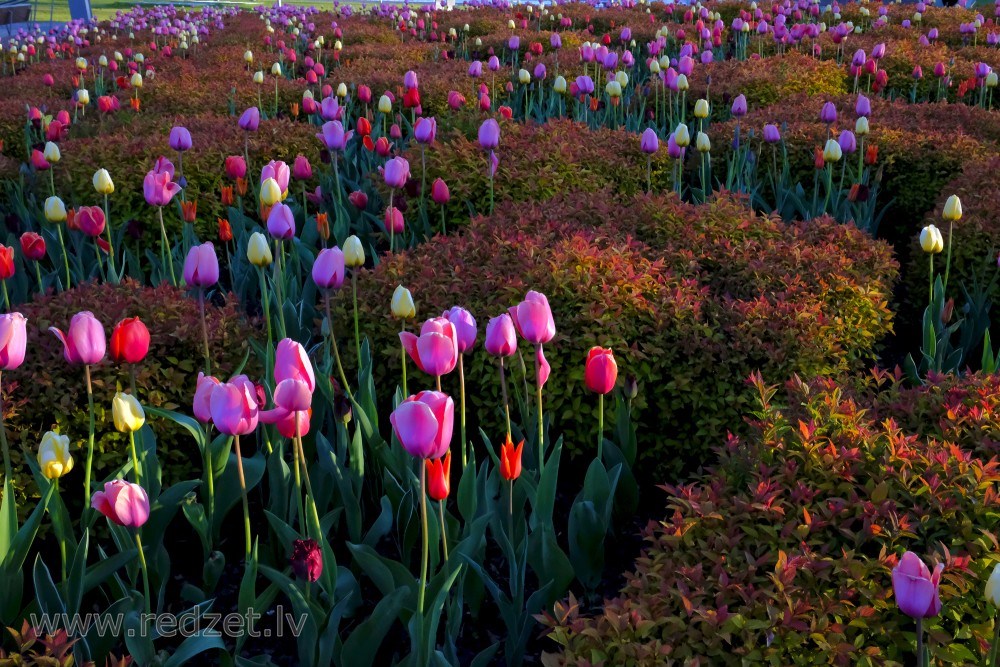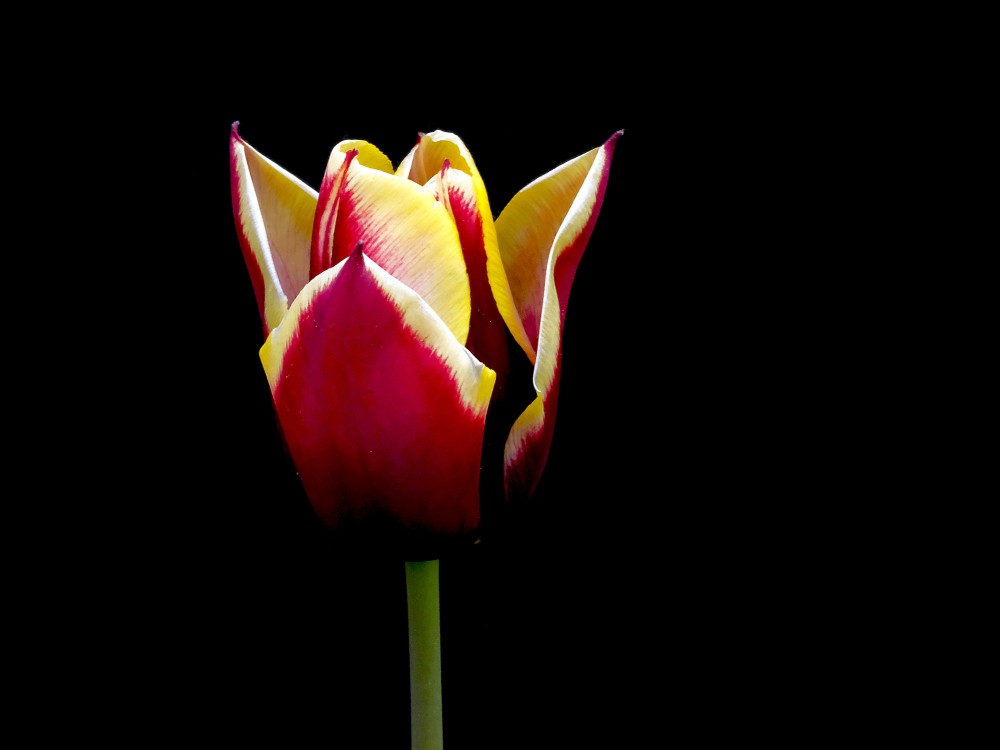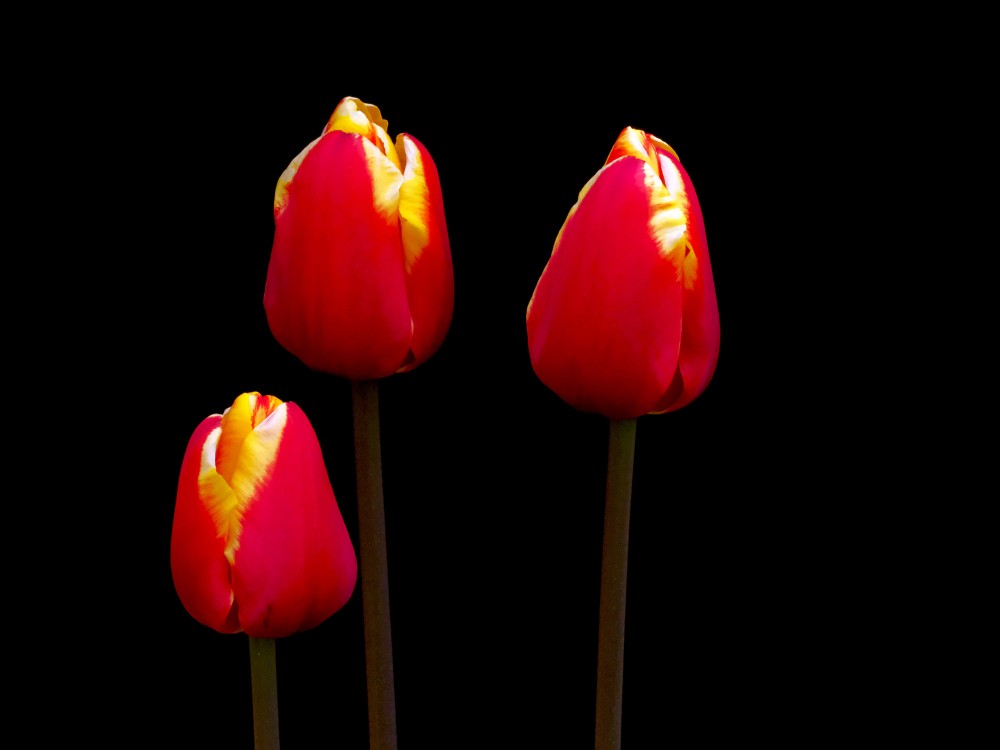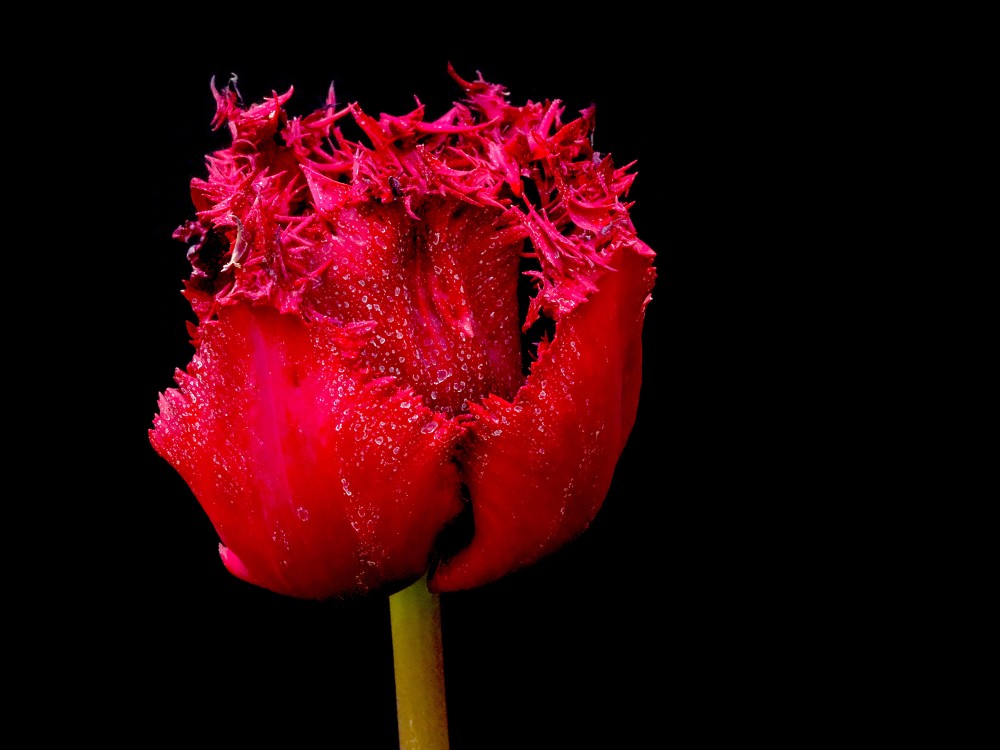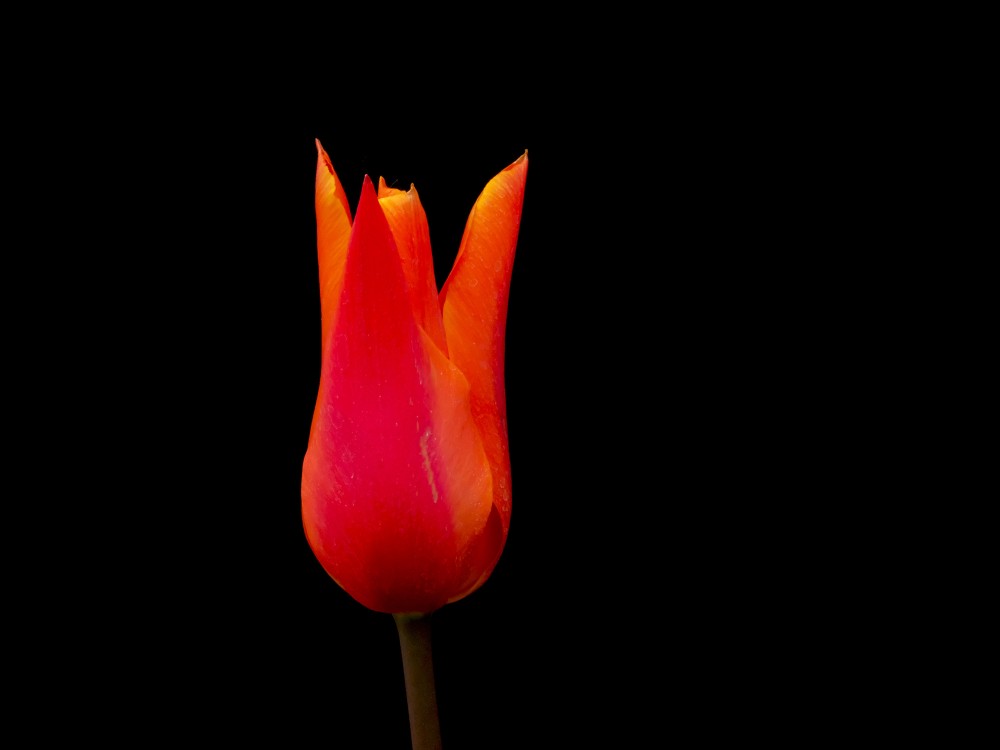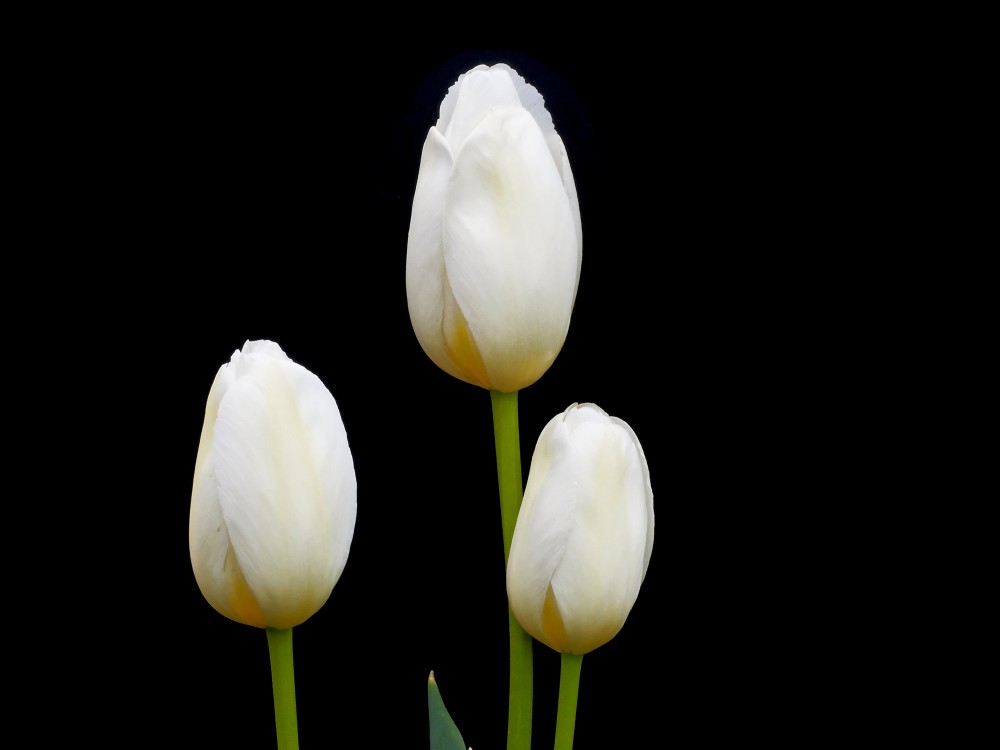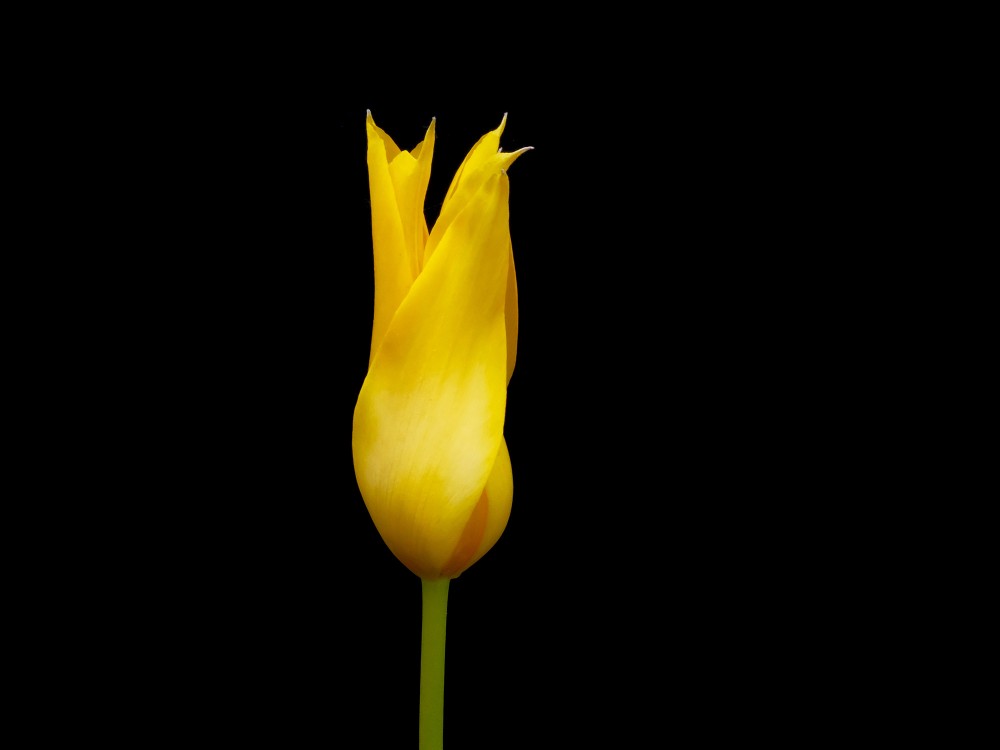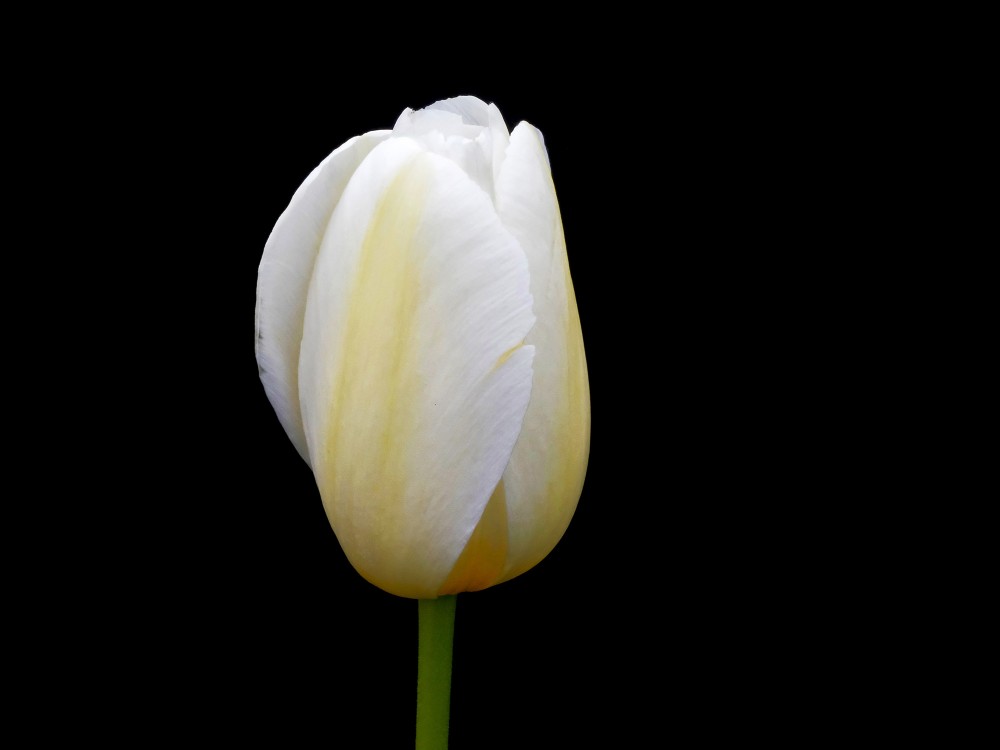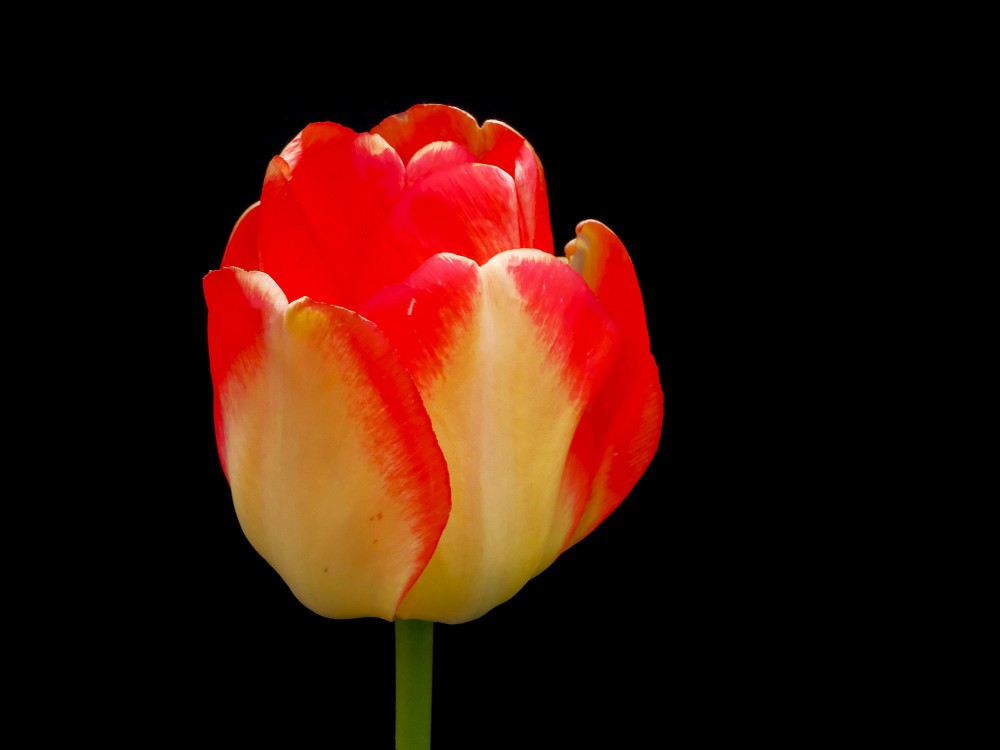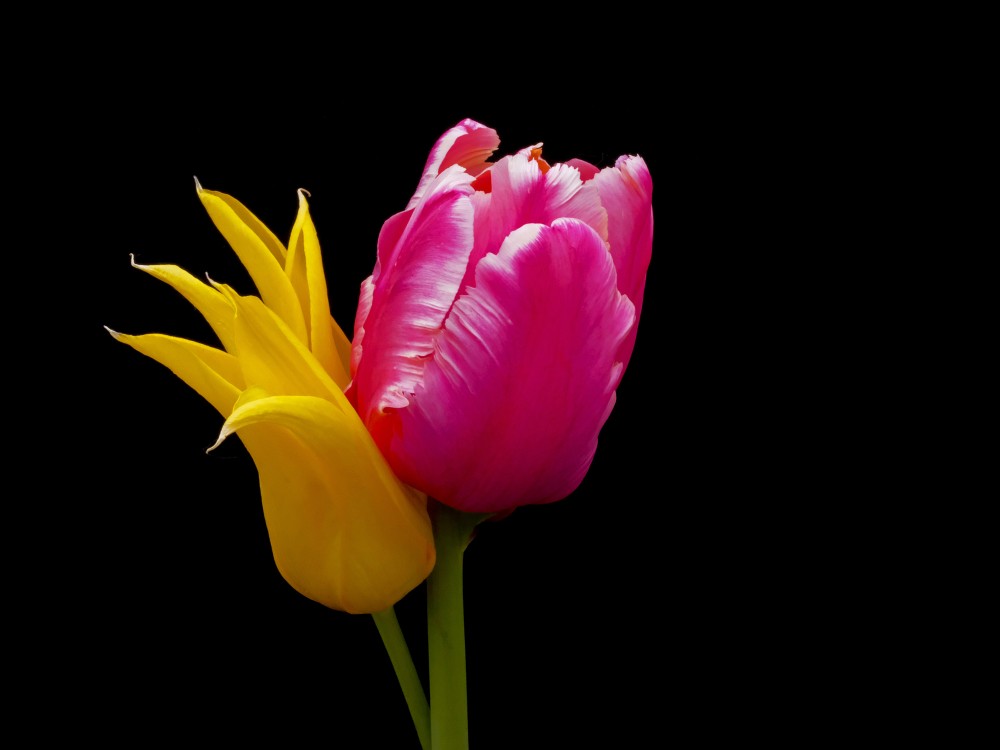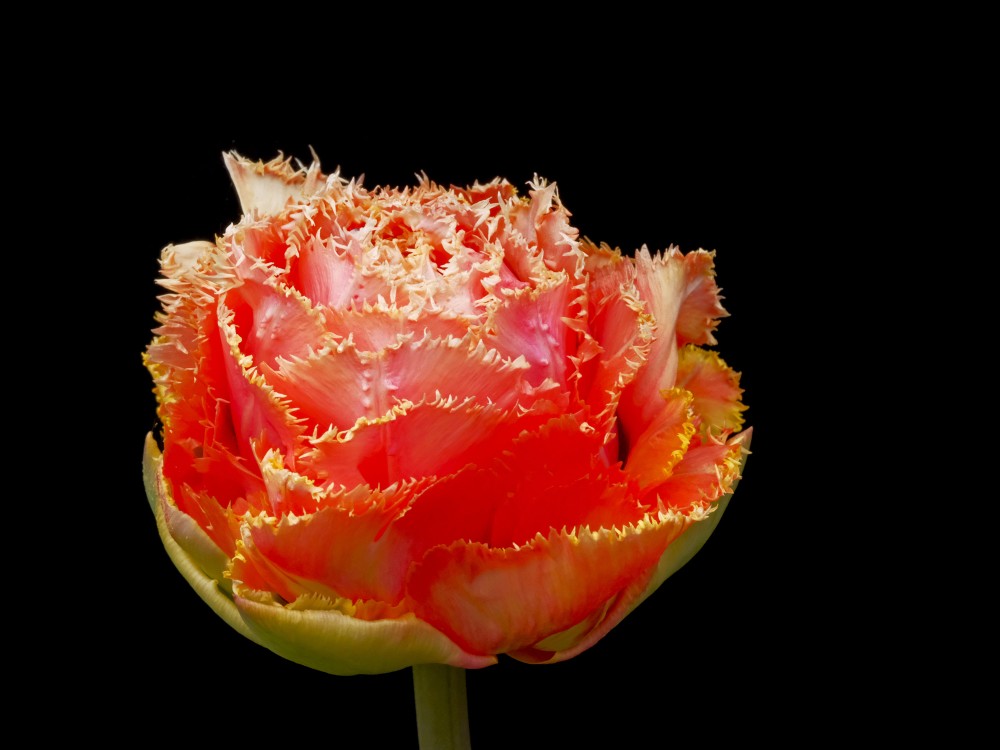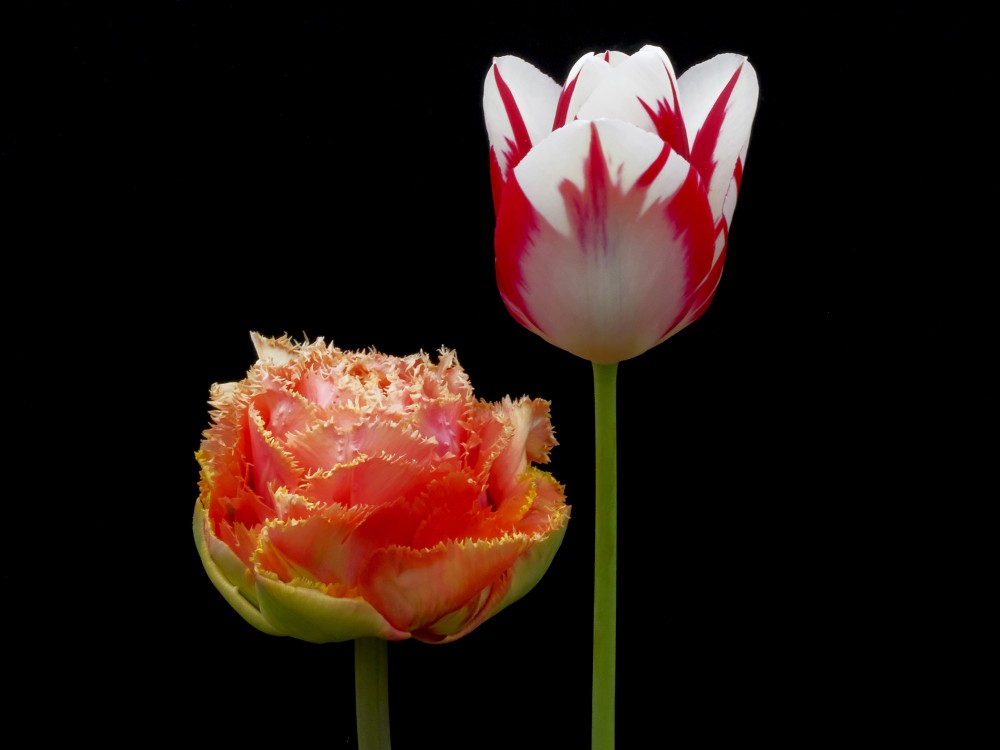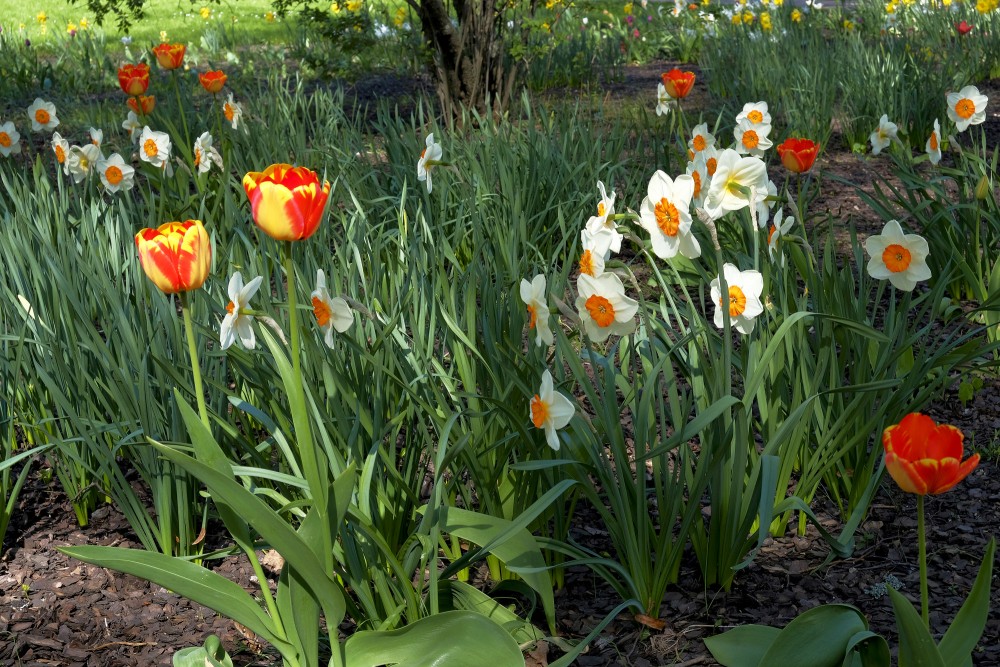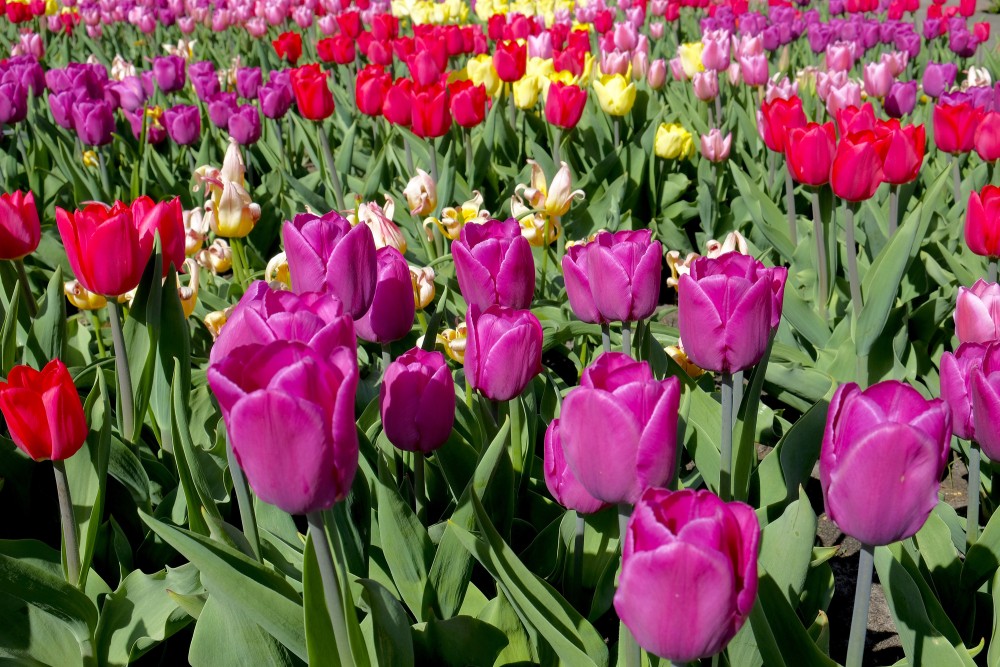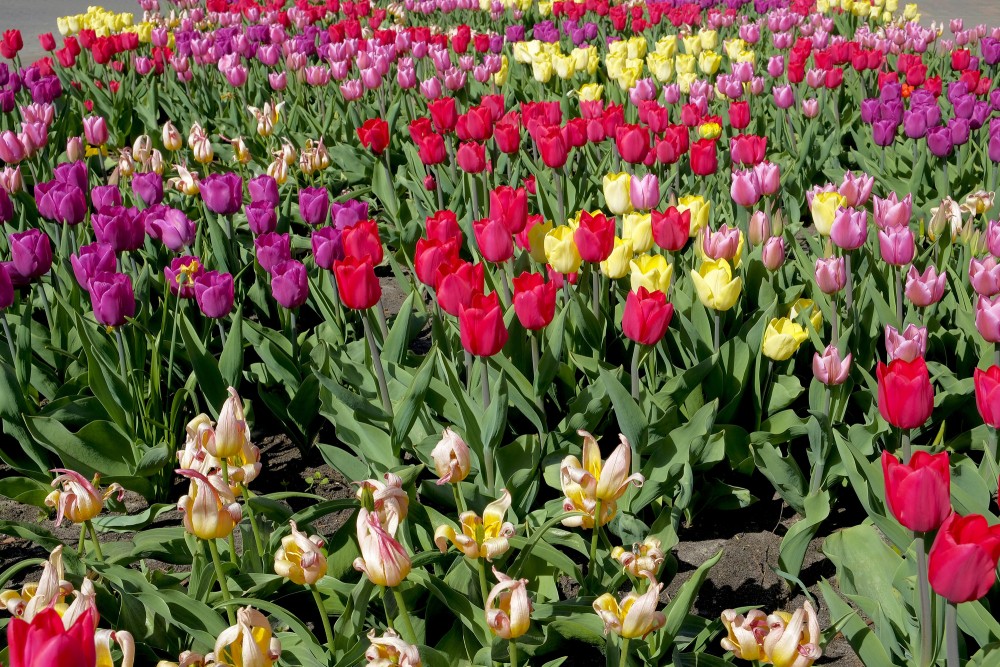Tulips (Tulipa)
Tulips (Tulipa) form a genus of spring-blooming perennial herbaceous bulbiferous geophytes (having bulbs as storage organs). The flowers are usually large, showy and brightly coloured, generally red, pink, yellow, or white (usually in warm colours). They often have a different coloured blotch at the base of the tepals (petals and sepals, collectively), internally. Because of a degree of variability within the populations, and a long history of cultivation, classification has been complex and controversial. The tulip is a member of the Liliaceae (lily) family, along with 14 other genera, where it is most closely related to Amana, Erythronium and Gagea in the tribe Lilieae. There are about 75 species, and these are divided among four subgenera. The name "tulip" is thought to be derived from a Persian word for turban, which it may have been thought to resemble. Tulips originally were found in a band stretching from Southern Europe to Central Asia, but since the seventeenth century have become widely naturalised and cultivated (see map). In their natural state they are adapted to steppes and mountainous areas with temperate climates. Flowering in the spring, they become dormant in the summer once the flowers and leaves die back, emerging above ground as a shoot from the underground bulb in early spring.
While tulips had probably been cultivated in Asia from the tenth century, they did not come to the attention of the West until the sixteenth century, when Western diplomats to the Ottoman court observed and reported on them. They were rapidly introduced into Europe and became a frenzied commodity during Tulip mania. Tulips were frequently depicted in Dutch Golden Age paintings, and have become associated with the Netherlands, the major producer for world markets, ever since. In the seventeenth century Netherlands, during the time of the Tulip mania, an infection of tulip bulbs by the tulip breaking virus created variegated patterns in the tulip flowers that were much admired and valued. While truly broken tulips do not exist anymore, the closest available specimens today are part of the group known as the Rembrandts – so named because Rembrandt painted some of the most admired breaks of his time.
Breeding programs have produced thousands of hybrid and cultivars in addition to the original species (known in horticulture as botanical tulips). They are popular throughout the world, both as ornamental garden plants and as cut flowers.
| Tulip | |
| Kingdom: | Plantae |
| Clade: | Angiosperms |
| Clade: | Monocots |
| Order: | Liliales |
| Family: | Liliaceae |
| Subfamily: | Lilioideae |
| Tribe: | Lilieae |
| Genus: | Tulipa |
Description
Tulipa (tulips) is a genus of spring-blooming perennial herbaceous bulbiferous geophytes, dying back after flowering to an underground storage bulb.
Flowers: The tulip's flowers are usually large and are actinomorphic (radially symmetric) and hermaphrodite (contain both male (androecium) and female (gynoecium) characteristics), generally erect, or more rarely pendulous, and are arranged more usually as a single terminal flower, or when pluriflor as two to three (e.g. Tulipa turkestanica), but up to four, flowers on the end of a floriferous stem (scape), which is single arising from amongst the basal leaf rosette. In structure, the flower is generally cup or star shaped. As with other members of Liliaceae the perianth is undifferentiated (perigonium) and biseriate (two whorled), formed from six free (i.e. apotepalous) caducous tepals arranged into two separate whorls of three parts (trimerous) each. The two whorls represent three petals and three sepals, but are termed tepals because they are nearly identical. The tepals are usually petaloid (petal like), being brightly coloured, but each whorl may be different, or have different coloured blotches at their bases, forming darker colouration on the interior surface. The inner petals have a small, delicate cleft at the top, while the sturdier outer ones form uninterrupted ovals. Tulip flowers come in a wide variety of colours, except pure blue (several tulips with "blue" in the name have a faint violet hue), and have absent nectaries. Tulip flowers are generally bereft of scent and are the coolest of floral characters. The Dutch regarded this lack of scent as a virtue, as it demonstrates the flower's chasteness.
Androecium: The flowers have six distinct, basifixed introrse stamens arranged in two whorls of three, which vary in length and may be glabrous or hairy. The filaments are shorter than the tepals, and dilated towards their base.
Gynoecium: The style is short or absent and each stigma has three distinct lobes, and the ovaries are superior, with three chambers.
Fruit: The tulip's fruit is a globose or ellipsoid capsule with a leathery covering and an ellipsoid to globe shape. Each capsule contains numerous flat, disc-shaped seeds in two rows per chamber. These light to dark brown seeds have very thin seed coats and endosperm that does not normally fill the entire seed.
Leaves: Tulip stems have few leaves. Larger species tend to have multiple leaves. Plants typically have two to six leaves, some species up to 12. The tulip's leaf is cauline (born on a stem), strap-shaped, with a waxy coating, and the leaves are alternate (alternately arranged on the stem), diminishing in size the further up the stem. These fleshy blades are often bluish-green in colour. The bulbs are truncated basally and elongated towards the apex. They are covered by a protective tunic (tunicate) which can be glabrous or hairy inside.
Distribution and habitat
Tulips are mainly distributed along a band corresponding to Latitude 40o north, from south-east of Europe (Ukraine, Russia) and Turkey in the west, through the Levant (Syria, Israel, Palestinian Territories, Lebanon and Jordan) and the Sinai Peninsula. From there it extends eastwards through Jerevan, (Armenia) and Baku (Azerbaijan) and on the eastern shore of the Caspian Sea through Turkmenistan, Bukhara, Samarkand and Tashkent (Uzbekistan), to the eastern end of the range in the Pamir-Alai and Tien-Shan mountains in Central Asia, which form the centre of diversity. Further to the east, Tulipa is found in the western Himalayas, southern Siberia, inner Mongolia, and as far as the northwest of China. While authorities have stated that no tulips west of the Balkans are native, subsequent identification of Tulipa sylvestris subsp. australis as a native of the Iberian peninsula and adjacent North Africa shows that this may be a simplification. In addition to these regions in the west tulips have been identified in Greece, Cyprus and the Balkans. In the south, Iran marks its furthest extent, while the northern limit is the Ukraine. Although tulips are also throughout most of the Mediterranean and Europe, these regions do not form part of the natural distribution. Tulips were brought to Europe by travelers and merchants from Anatolia and Central Asia for cultivation, from where they escaped and naturalised (see map). For instance, less than a half of those species found in Turkey are actually native. These have been referred to as neo-tulipae.
Tulips are indigenous to mountainous areas with temperate climates, where they are a common element of steppe and winter-rain Mediterranean vegetation. They thrive in climates with long, cool springs and dry summers. Tulips are most commonly found in meadows, steppes and chaparral, but also introduced in fields, orchards, roadsides and abandoned gardens.
Ecology
Botrytis tulipae is a major fungal disease affecting tulips, causing cell death and eventually the rotting of the plant. Other pathogens include anthracnose, bacterial soft rot, blight caused by Sclerotium rolfsii, bulb nematodes, other rots including blue molds, black molds and mushy rot.
The fungus Trichoderma viride can infect tulips, producing dried leaf tips and reduced growth, although symptoms are usually mild and only present on bulbs growing in glasshouses.
Variegated tulips admired during the Dutch tulipomania gained their delicately feathered patterns from an infection with the tulip breaking virus, a mosaic virus that was carried by the green peach aphid, Myzus persicae. While the virus produces fantastically streaked flowers, it also weakens plants and reduces the number of offsets produced. Dutch growers would go to extraordinary lengths during tulipomania to make tulips break, borrowing alchemists’ techniques and resorting to sprinkling paint powders of the desired hue or pigeon droppings onto flower roots.
Tulips affected by mosaic virus are called "broken"; while such plants can occasionally revert to a plain or solid colouring, they will remain infected and have to be destroyed. Today the virus is almost eradicated from tulip growers' fields. The multicoloured patterns of modern varieties result from breeding; they normally have solid, un-feathered borders between the colours.
Tulip growth is also dependent on temperature conditions. Slightly germinated plants show greater growth if subjected to a period of cool dormancy, known as vernalisation. Furthermore, although flower development is induced at warmer temperatures (20–25 °C), elongation of the flower stalk and proper flowering is dependent on an extended period of low temperature (<10 °C). Tulip bulbs imported to warm-winter areas are often planted in autumn to be treated as annuals.
The colour of tulip flowers also vary with growing conditions.
en.wikipedia.org
